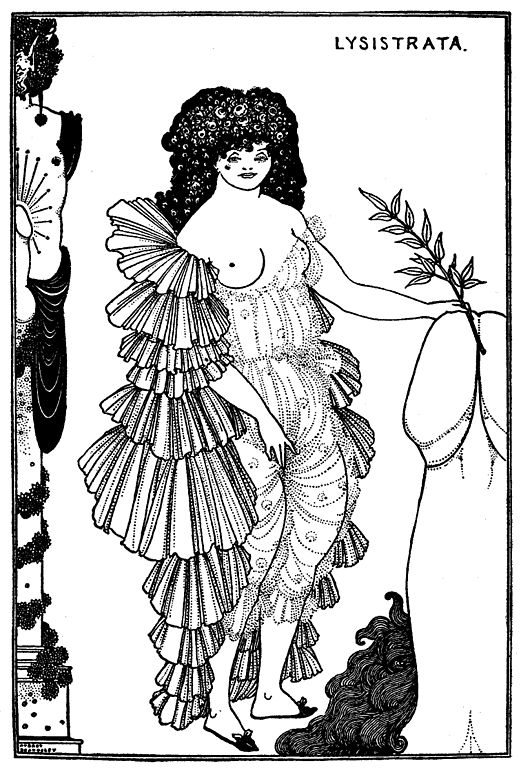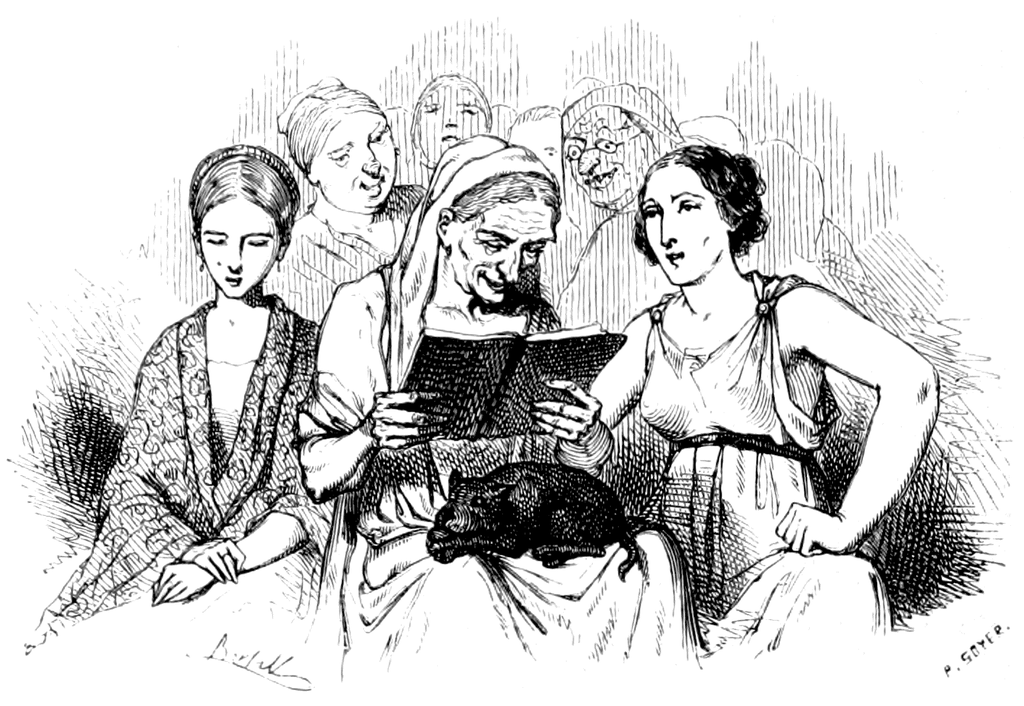Lysistrata – Aristophanes | Summary, Characters & Analysis | Classical Literature
(Comedy, Greek, 411 BCE, 1,320 lines)
Introduction – Is Lysistrata a Tragedy or Comedy | Back to Top of Page |
“Lysistrata” is a bawdy anti-war comedy by the ancient Greek playwright Aristophanes, first staged in 411 BCE. It is the comic account of one woman’s extraordinary mission to end the Peloponnesian War, as Lysistrata convinces the women of Greece to withhold sexual privileges from their husbands as a means of forcing the men to negotiate a peace. Some consider it his greatest work, and it is probably the most anthologized.
Synopsis – Lysistrata Summary | Back to Top of Page |
|
 Lysistrata, a strong Athenian woman with a great sense of individual responsibility, reveals her plan to take matters into her own hands and end the interminable Peloponnesian War between Athens and Sparta.
Lysistrata, a strong Athenian woman with a great sense of individual responsibility, reveals her plan to take matters into her own hands and end the interminable Peloponnesian War between Athens and Sparta.
She has convened a meeting of women from various city states in Greece and, with support from the Spartan Lampito, she explains to the other women her plan: that they are to withhold sexual privileges from their menfolk as a means of forcing them to bring an end to the war.
The women are dubious and reluctant at first, but the deal is sealed with a long and solemn oath around a wine bowl, and the women agree to abjure all sexual pleasures, including various specifically mentioned sexual positions. At the same time, another part of Lysistrata’s plan (a precautionary measure) comes to fruition as the old women of Athens seize control of the nearby Acropolis, which holds the state treasury, without which the men cannot long continue to fund their war. The word of revolt is spread and the other women retreat behind the barred gates of the Acropolis to await the men’s response.
A Chorus of bumbling old men arrives, intent on burning down the gate of the Acropolis if the women do not open up. However, before the men can make their preparations, a second Chorus of old women arrives bearing pitchers of water. An argument ensues and threats are exchanged, but the old women successfully defend their younger comrades and the old men receive a good soaking in the process.
A magistrate reflects on the hysterical nature of women and their devotion to wine, promiscuous sex and exotic cults, but above all he blames the men for the poor supervision of their womenfolk. He needs silver from the treasury for the war effort, and he and his constables try to break into the Acropolis, but are quickly overwhelmed by groups of unruly women with long, strange names.
 Lysistrata restores some order after the fracas, and allows the magistrate to question her about her scheme and the war. She explains to him the frustrations that women feel at a time of war, when the men make stupid decisions that affect everyone and their wive’s opinions are not listened to. She expresses pity for the young, childless women, left to grow old at home during the best years of their lives, while the men are away on endless military campaigns, and she constructs an elaborate analogy in which she shows that Athens should be structured as a woman would spin wool. To illustrate her points, Lysistrata and the women dress the magistrate up, first as a woman and then as a corpse. Eventually, he storms off to report the incident to his colleagues, and Lysistrata returns to the Acropolis.
Lysistrata restores some order after the fracas, and allows the magistrate to question her about her scheme and the war. She explains to him the frustrations that women feel at a time of war, when the men make stupid decisions that affect everyone and their wive’s opinions are not listened to. She expresses pity for the young, childless women, left to grow old at home during the best years of their lives, while the men are away on endless military campaigns, and she constructs an elaborate analogy in which she shows that Athens should be structured as a woman would spin wool. To illustrate her points, Lysistrata and the women dress the magistrate up, first as a woman and then as a corpse. Eventually, he storms off to report the incident to his colleagues, and Lysistrata returns to the Acropolis.
The debate is continued between the Chorus of old men and the Chorus of old women, until Lysistrata returns with the news that some of the women are already becoming desperate for sex, and they are beginning to desert the cause on the silliest of pretexts (such as to air bedding and do other chores) and one is even caught trying to escape to a brothel. She succeeds in rallying her comrades, however, and restoring their discipline, and she returns yet again to the Acropolis to await for the men’s surrender. Meanwhile, Cinesias, the young husband of Myrrhine, appears, desperate for sex. As Lysistrata oversees the discussion, Myrrhine reminds him of the terms, and further taunts her husband by preparing an inviting bed, oils, etc, before disappointing the young man by locking herself in the Acropolis again.
The Chorus of old women make overtures to the old men, and soon the two Choruses merge, singing and dancing in unison. The peace talks commence and Lysistrata introduces the Spartan and Athenian delegates to a gorgeous naked young woman called Reconciliation or Peace, whom the delegates cannot take their eyes off. Lysistrata scolds both sides for past errors of judgement and, after some squabbles over the peace terms (and with the naked figure of Reconciliation before them and the burden of sexual deprivation still heavy upon them), they quickly overcome their differences and retire to the Acropolis for celebrations, songs and dancing.
Lysistrata analysis | Back to Top of Page |
 “Lysistrata” was first staged in 411 BCE, just two years after Athens’ catastrophic defeat in the Sicilian Expedition, a turning-point in the long-running Peloponnesian War aginst Sparta, and, after 21 years of war, there seemed as little prospect of peace as ever. The oligarchic revolution in Athens, which proved briefly successful that same year, was more political fall-out from the Sicilian disaster was. The name Lysistrata can be translated as “releaser of war” or “army disbander”.
“Lysistrata” was first staged in 411 BCE, just two years after Athens’ catastrophic defeat in the Sicilian Expedition, a turning-point in the long-running Peloponnesian War aginst Sparta, and, after 21 years of war, there seemed as little prospect of peace as ever. The oligarchic revolution in Athens, which proved briefly successful that same year, was more political fall-out from the Sicilian disaster was. The name Lysistrata can be translated as “releaser of war” or “army disbander”.
Modern adaptations of the play are often femininist and/or pacifist in their aim, but the original play was neither particularly feminist nor unreservedly pacifist. Even while apparently demonstrating empathy with the female condition, Aristophanes still tended to reinforce sexual stereotyping of women as irrational creatures in need of protection from themselves and from others. Certainly, it seems clear that Aristophanes was not actually advocating real political power for women.
It should be remembered that this was a time when women did not have the vote, and when men had ample opportunities to whet their sexual appetites elsewhere. Indeed, the very idea that a woman could have enough influence to end a war would have been considered quite ridiculous to the Greek audience members. Interestingly, when establishing the rules of the sex ban, Lysistrata also makes allowance for cases where the woman is forced to yield, in which case they should do so with an ill grace and in such a way as to afford the minimum of gratification to their partner, remaining passive and taking no more part in the amorous game than they are absolutely obliged to.
An added twist to the gender battle arises from the fact that, although the gender roles were reversed (with the women acting like men, to some extent, in taking the political initiative, and the men behaving more like women), in the Greek theatre ALL the actors were actually male anyway. The male characters in the play would probably have worn large, erect leather phalluses.
Lysistrata herself, though, is clearly an exceptional woman and, even when the other women waver in their resolution, she remains strong and committed. She is usually quite separate from the other women: she does not herself exhibit any sexual desire, has no obvious lovers or husband and does not purposely flirt with men; she is smarter, wittier and generally adopts a more serious tone than the other women, and uses different language. For these reasons, both the magistrate and the delegates seem to give her more respect and, by the end of the play, she has demonstrated her power over men, with even the respected leaders of Greece submissive to her arguments.
 There are many parallels between “Lysistrata” and “The Knights” (where the protagonist is also an improbable saviour of Athens), as well as with two of Aristophanes‘ other plays on the theme of peace, “The Acharnians” and “Peace” (particularly his use of allegorical figures full of sexual innuendo, like the figure of Reconciliation or Peace). “Thesmophoriazusae”, another of Aristophanes‘ plays with a focus on gender-based issues, was presented in the very same year as “Lysistrata”.
There are many parallels between “Lysistrata” and “The Knights” (where the protagonist is also an improbable saviour of Athens), as well as with two of Aristophanes‘ other plays on the theme of peace, “The Acharnians” and “Peace” (particularly his use of allegorical figures full of sexual innuendo, like the figure of Reconciliation or Peace). “Thesmophoriazusae”, another of Aristophanes‘ plays with a focus on gender-based issues, was presented in the very same year as “Lysistrata”.
Like all of Aristophanes‘ plays (and Old Comedy in general), the humour is highly topical and the playwright expected his audience to be familiar with myriad local personalities, places and issues, a difficulty faced by any producer trying to stage “Lysistrata” for modern audiences. As well as the slapstick humour and the raucous and risqué double-entendres, much of the humour in the play derives from the audience’s knowledge of specific figures from Athens’ public life and recent history.
“Lysistrata” belongs to the middle period of Aristophanes‘ career, however, when he was beginning to diverge significantly from the conventions of Old Comedy. For instance, it incorporates a double Chorus (which begins the play divided against itself – old men versus old women – but later unites to exemplify the major theme of the play, reconciliation), there is no conventional parabasis (where the Chorus addresses the audience directly) and it has an unusual agon or debate (in that the protagonist, Lysistrata, does almost all the talking, both questions and answers, while the antagonist – the magistrate – merely asks the odd question or expresses indignation). The character of Lysistrata herself acts very much as the mastermind of the action, and almost at times as an on-stage director.
Resources | Back to Top of Page |
- English translation by George Theodoridis (Poetry in Translation): http://www.poetryintranslation.com/PITBR/Greek/Lysistrata.htm
- Greek version with word-by-word translation (Perseus Project): http://www.perseus.tufts.edu/hopper/text.jsp?doc=Perseus:text:1999.01.0035
[rating_form id=”1″]

